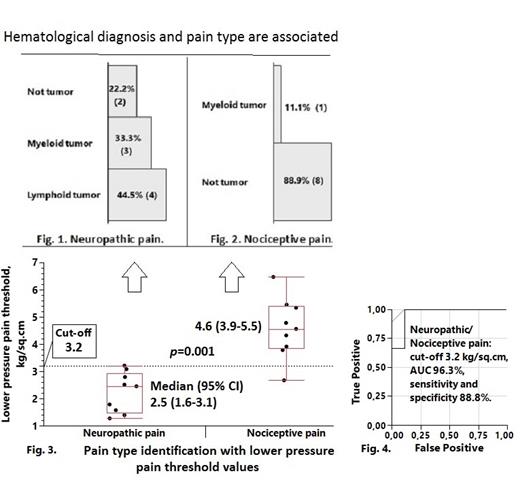Abstract
Background: Pain is defined as an unpleasant sensory and emotional experience associated with actual or potential tissue damage according to the International Association for the Study of Pain.
Aim: To estimate distinguishing features of the pain in patients with blood disorders.
Patients and Methods: The prospective exploratory study was conducted in the National Research Center for Hematology, Moscow from 11/2015 to 01/2021. In total, 40 patients (pts) with blood disorders who had a difficult-to-control pain syndrome were included in the study. There were 21 men (median age of 41.5, IQR 35.0-56.3 years) and 19 women (median age of 40, IQR 34.3-56.0 years). The pain types were determined according to clinical symptoms and the use of special questionnaires (i.e., the Douleur Neuropathique 4 Questions questionnaire for neuropathic pain). Pressure algometry was used to assess pain tolerance of the non-dominant hand by evaluating the pressure pain threshold (PPT, kg/cm 2), which is the minimum pressure required to induce pain.
Results: Four types of pain were identified: neuropathic in 9 pts (22.5%), nociceptive in 9 pts (22.5%), their mix (summing up to a half of the total number of cases ‒ 52.5%, 21 pts) and dysfunctional pain in only 1 patient (2.5%). The distribution based on the pain types was uneven (Kolmogorov test, p = 0.05). The different pain types were related with various distributions of blood disorders: lymphoid tumor (44.5%), myeloid tumor (33.3%) and not tumor (22.2%) (associated with neuropathic pain) and myeloid tumor (88.9%) and not tumor (11.1%) (associated with nociceptive pain) (Figs. 1 and 2) . The tolerance of neuropathic and nociceptive pain types turned out to be significantly different (PPT medians with 95% CI): 2.2 kg/cm 2 (1.6-3.1) vs. 4.6 kg/cm 2 (3.9-5.5), respectively, and (found in ROC-analysis) the cut-off was 3.2 kg/cm 2,AUC (the area under ROC curve) 96.3%, sensitivity and specificity 88.8% (Fig. 3 and 4). PPT cut-off points, that shares the mixed pain (median 2.7 kg/cm 2, 95 CI 1.9-3.6) on the neuropathic and nociceptive pain are: 3.2 kg/cm 2 (AUC 67.0%) and 3.8 kg/cm 2 (AUC 86.7%), respectively. Several measurements of PPT (with taking into account the cut-off) in patient, suffering from pain, can help identify with a high probability his type of pain, and accordingly (indirectly), his blood type disorder.
Conclusions: Measuring PPT in a pts with blood disorders allows to identify the type of pain (neuropathic, nociceptive, or combined), which can serve as an additional source of information for accurate diagnosis and treatment.
No relevant conflicts of interest to declare.


This feature is available to Subscribers Only
Sign In or Create an Account Close Modal